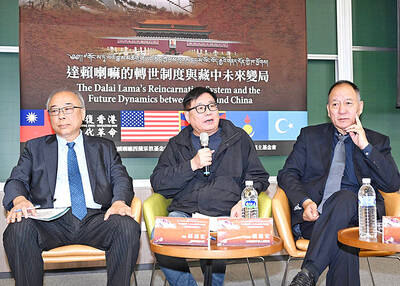Taiwan is to develop a non-lethal graphite bomb designed to disable China's power supplies, reports said yesterday.
Should war break out, the so-called "blackout bombs" would be carried by Hsiung Feng II-E cruise missiles to paralyze power grids in China's southeastern coastal cities, the Chinese-language United Daily News said.
The bombs work by sprinkling a cloud of chemically treated carbon fibers over power supplies, causing them to short-circuit, but without killing people, the report said.
If approved, the Chungshan Institute of Science and Technology -- the nation's top weapons research unit -- would begin research and development of the weaponry, at a cost of up to NT$500 million (US$15.34 million), beginning next year, the report said.
The Ministry of Defense declined to comment on the claims.
Reports said the US used the graphite bomb against Iraq in the Gulf War in 1991, wiping out 85 percent of its electrical supply. A similar version was used by NATO against Serbia in 1999.
Rocky relations between Taiwan and China look set to continue after President Chen Shui-bian (陳水扁) dismissed an offer of a peace treaty with China, saying it would be like agreeing to "a treaty of surrender."
Speaking to the International Herald Tribune last week, Chen said that China's call for the signing of a peace agreement with Taipei under the "one China" principle was made in terms that made it unacceptable.
Chinese President Hu Jintao (
Taiwan flexed its military muscle earlier this month, showing off two domestically developed missiles during the Double Ten National Day military parade seen as a reminder to China that it has the means to defend itself.

ALIGNED THINKING: Taiwan and Japan have a mutual interest in trade, culture and engineering, and can work together for stability, Cho Jung-tai said Taiwan and Japan are two like-minded countries willing to work together to form a “safety barrier” in the Indo-Pacific region, Premier Cho Jung-tai (卓榮泰) yesterday said at the opening ceremony of the 35th Taiwan-Japan Modern Engineering and Technology Symposium in Taipei. Taiwan and Japan are close geographically and closer emotionally, he added. Citing the overflowing of a barrier lake in the Mataian River (馬太鞍溪) in September, Cho said the submersible water level sensors given by Japan during the disaster helped Taiwan monitor the lake’s water levels more accurately. Japan also provided a lot of vaccines early in the outbreak of the COVID-19 pandemic,

Kaohsiung Mayor Chen Chi-mai (陳其邁) on Monday announced light shows and themed traffic lights to welcome fans of South Korean pop group Twice to the port city. The group is to play Kaohsiung on Saturday as part of its “This Is For” world tour. It would be the group’s first performance in Taiwan since its debut 10 years ago. The all-female group consists of five South Koreans, three Japanese and Tainan’s Chou Tzu-yu (周子瑜), the first Taiwan-born and raised member of a South Korean girl group. To promote the group’s arrival, the city has been holding a series of events, including a pop-up

TEMPORAL/SPIRITUAL: Beijing’s claim that the next Buddhist leader must come from China is a heavy-handed political maneuver that will fall flat-faced, experts said China’s requirement that the Dalai Lama’s reincarnation to be born in China and approved by Beijing has drawn criticism, with experts at a forum in Taipei yesterday saying that if Beijing were to put forth its own Dalai Lama, the person would not be recognized by the Tibetan Buddhist community. The experts made a remarks at the two-day forum hosted by the Tibet Religious Foundation of His Holiness the Dalai Lama titled: “The Snow Land Forum: Finding Common Ground on Tibet.” China says it has the right to determine the Dalai Lama’s reincarnation, as it claims sovereignty over Tibet since ancient times,

Temperatures in some parts of Taiwan are expected to fall sharply to lows of 15°C later this week as seasonal northeasterly winds strengthen, the Central Weather Administration (CWA) said today. It is to be the strongest cold wave to affect northern Taiwan this autumn, while Chiayi County in the southwest and some parts of central Taiwan are likely to also see lower temperatures due to radiational cooling, which occurs under conditions of clear skies, light winds and dry weather, the CWA said. Across Taiwan, temperatures are to fall gradually this week, dropping to 15°C to 16°C in the early hours of Wednesday